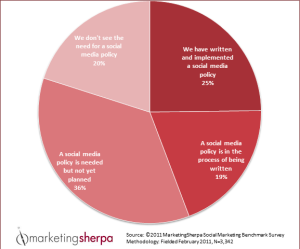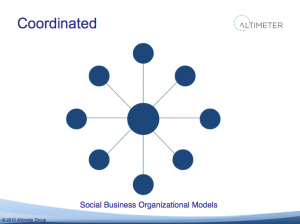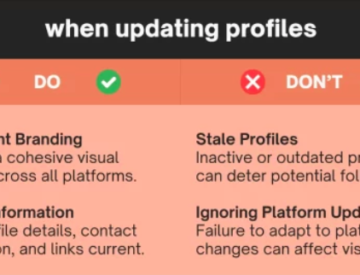 According to a 2011 survey by MarketingSherpa, only 25% of companies said they had a social media policy in place. Perhaps even more telling is the fact that 56% of surveyed respondents did not see the need for one or didn’t intend to implement one shortly.
According to a 2011 survey by MarketingSherpa, only 25% of companies said they had a social media policy in place. Perhaps even more telling is the fact that 56% of surveyed respondents did not see the need for one or didn’t intend to implement one shortly.
Yet having a social media policy in place is a good practice, putting safeguards in place to help organizations, employees and stakeholders alike navigate in the ever increasingly evolving sphere of social media.
There are essentially three good reasons to have a social media policy in place.
1. Protect the employee
Many experts claim that we can simply tell employees to use “common sense” when posting things online, whether text content, links to articles, photos and videos. But truth be told, “common sense” is often a loose term, in particular when one arrives into a new corporate culture, not knowing the way things are being done or said around the office.
For example, should you friend your colleague, your boss or employees on Facebook? Can you tweet with reference to your employer? If you blog, or comment on blogs, should you let it be known who your employer is?
These are the types of questions usually addressed in a social media policy and in social media training for staff and providers for bigger corporations. And this is not exclusive to employees who tweet or post on behalf of a company: anybody with access to social media ought to be included in a thorough policy.
2. Protect the organization
Protecting the employee by providing guidelines helps explaining accepted behaviors, and those that are frowned upon. Intimidation is rarely accepted in the workplace, so it shouldn’t be accepted either in social media between employees or with external parties.
Detailing these aspects thus helps organizations take necessary action when necessary, ensuring a healthy workplace and due diligence from a human resources point of view.
A good example is how the State of Victoria, in Australia, has developed a simple and effective set of guidelines, as can be seen in this video:
A policy that leaves space for some freedom
Having a good social media policy in place also helps determine who is entitled to speak on behalf of the company, who manages social media accounts, and what kind of confidential information about the company can or cannot be shared online.
It can take 20 years to build a brand, but only 5 minutes to ruin it – Warren Buffett
Caution: there is a fine line between guidelines and control. Some companies try to exert tight control over employees in the social media sphere, with controversial results. It was the case recently with GM, Target and DISH Networks that were deemed illegal by labor officials.
Another example is the Organizing Committee for the 2012 Olympic Games that has developed a very stringent social media policy for athletes, sponsors, media and participants in the upcoming event. We can all understand the need to protect the exclusive sponsorships with the big money involved, but stringent control over photos, videos and texts during the two-week event appears simply impossible.
3- Clarify organizational structure
By defining who is responsible for social media interactions on behalf of the organization, management gets a golden opportunity to define which department should be held accountable for its strategy and execution. Most companies start out with a centralized approach, where social media resides either under Marketing, Public Relations, IT, Customer Service or any other given department.
But with experience comes a more decentralized approach, coordinated through multifunctional teams, accountable under a specific department or the CEO directly, depending on size of companies.
We also find a more evolved organizational model, where every employee is a brand ambassador with access to social media as part of the job definition, or encouraged by senior management. The best example can be found at Zappos. Read here for the Brian Solis post on this story
Different structure, different approach
No matter which organizational model is in place for your social media management, guidelines should clearly define what is expected from employees in this sphere. If a customer service employee is now expected to spend one hour a day to monitor and respond on Twitter on behalf of the company, proper training should follow, as with job descriptions reviews.
This employee should then be able to tread the social media environment, whether it’s responding for official purposes via a corporate account or later on during personal time, responding on blog posts via a personal account. In today’s world, where transparency and authenticity are key, having a strong social media policy in place to help all parties evolve is no longer a luxury, but a necessity.










Leave a Reply